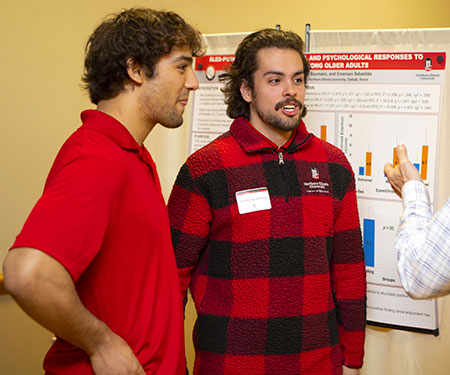
Emerson Sebastião’s first experience as a mentor for NIU’s Conference on Undergraduate Research and Engagement left him hungry for more.
That his 2022 debut came with a Faculty Mentor of the Year award makes it even sweeter.
“Students who submit a proposal have the option to nominate their mentor for the award, and one of my students nominated me and spoke very highly about the way I worked with him,” says Sebastião, assistant professor of Exercise Science in the Department of Kinesiology and Physical Education. “I was very surprised, to be honest, because there were more than 100 posters, and consequently, a lot of excellent faculty mentors.”
Held in April, the Office of Student Engagement and Experiential Learning’s Conference on Undergraduate Research and Engagement (CURE) symposium showcases faculty-mentored projects from all colleges.
Kinesiology majors Matthew Herring and Ricardo Salinas, who worked under the guidance of Sebastião and KNPE graduate student Michael Baumann, presented “Sled-Push Exercise: Physiological and Psychological Responses to an Acute Session among Older Adults.”
The concept originated with Sebastião, whose research interests include physical activity and exercise in older adults.
“Normally, older adults report a lack of accessibility as a barrier for low levels of to exercise participation, mostly because they either have to travel or they do not identify with the particular facility, and, when they are there, the large array of equipment can be overwhelming as they are not sure how to use them,” Sebastião says.
“In looking for different exercises programs or exercise modalities,” he adds, “I came across this paper that used this novel sled-push that is different than the traditional sled highly used among athletes, which requires a specific environment – synthetic grass, for example – that’s not very practical for older adults.”

Built with wheels and designed to provide resistance through an attached motor, preventing the need for users to add heavy weights, the XPO Trainer intrigued Sebastião.
“When I saw that particular equipment, I saw that it might be good for older adults because you can use it anywhere, especially in retirement communities. You do not have to be in a gym to exercise your heart or the muscles on your leg. You can do it on your driveway, if you will,” he says. “That’s why it sparked my interest to try to examine, systematically, that particular equipment in older adults.”
First, the project was offered to Baumann as a subject for his master’s thesis: How would the benefits of pushing the sled compare to the benefits of simply walking?
Eighteen adults age 65 and older were randomly allocated into either sled-push or walking groups; participants made six trips at different velocities on a 30-meter course with two-minute rest periods in between.
Once Sebastião and Baumann launched that work on top of their other projects, however, they realized the need for help with data collection.
Recruitment from a KNPE 494: Internship in Kinesiology class yielded Herring and Salinas; NIU Research Rookies Bianca Estrada and Makayla Hurd also came on board, along with Exercise Science Club member Elise Craven.

All received training on the various assessments – blood pressure and blood lactate; heart rate; rate of perceived exertion; and level of enjoyment – and took turns taking notes and measurements.
For Herring and Salinas, those roles also led to presenting at CURE, where they reported results showing that the sled generated enough intensity to elucidate positive cardiovascular gains for those participants and that enjoyment levels were high and similar for both groups.
“Most of the things that we did throughout the research project, Matthew and Ricardo already had seen in the classroom, so they were able to get the knowledge from the classroom and see how that theory applies to the real world,” Sebastião says. “They were able to see a little bit of the work that we do as faculty when we take a job in academia.”
That includes data collection and interpretation as well as writing papers, something the pair are now engaged in with Sebastião and Baumann.
In doing so, Sebastião hopes that the undergraduates continue to glimpse in him what prompted their nomination.

“I have a passion for research, and I want to transmit that and help train the future scientists, researchers and scholars in the field,” he says. “This is a part of my job that I enjoy most – being in the lab, teaching others to do the things that I do and maybe sparking in them the interest to become researchers in the future. I think the students see that in me every time I step in the classroom.”
Consequently, he expects to become an annual mentor of CURE students.
“The name of the event speaks for itself: the Conference for Undergraduate Research and Engagement,” Sebastião says. “It’s a very important opportunity to put our students out there on kind of a first step before taking them outside to a national or even international conference so they get the feeling of what to expect and how to prepare for that level of responsibility.”

